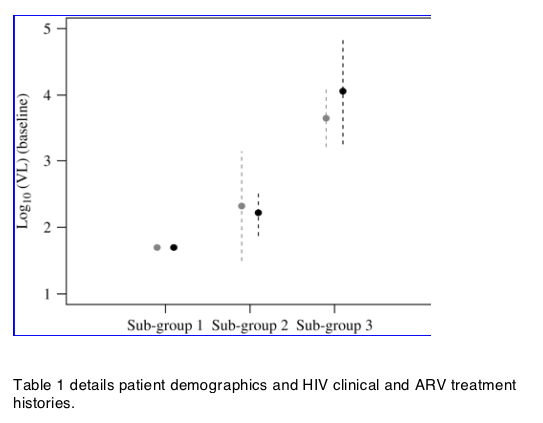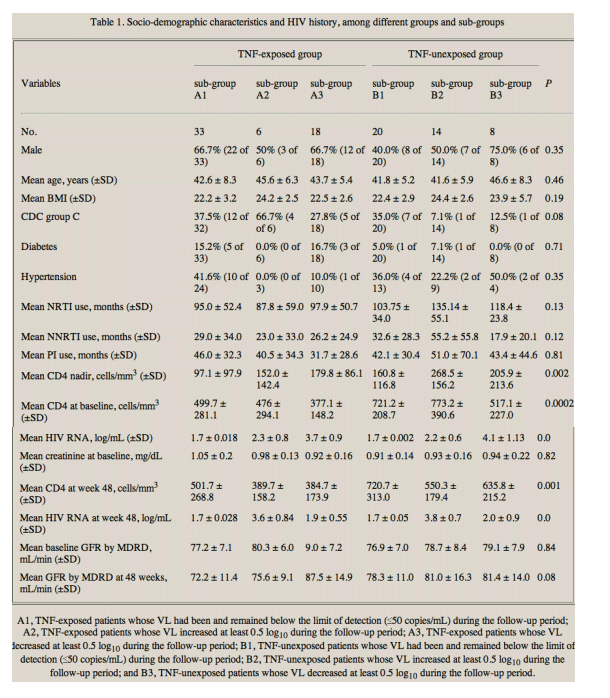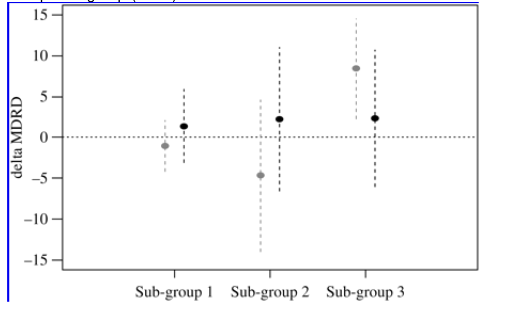| |
Glomerular filtration rates in HIV-infected patients treated with and without tenofovir: a prospective, observational study
|
| |
| |
Journal of Antimicrobial Chemotherapy Feb 2009 63(2):374-379; doi:10.1093/jac/dkn499
Giovanni Guaraldi1,*, Alberto Roverato2, Chiara Giovanardi1, Federica Ravera1, Nicola Squillace1, Gabriella Orlando1, Gianni Cappelli1, Roberto Esposito1 and Frank Palella3
1 Dipartimento di Medicine e Specialita Mediche, University of Modena and Reggio Emilia, Modena, Italy 2 Dipartimento di Scienze Statistiche, University of Bologna, Bologna, Italy 3 Division of Infectious Diseases, Northwestern University Feinberg School of Medicine, Chicago, IL, USA
Abstract
Objectives: The aim of our study was to assess the impact of plasma HIV-1 RNA level [viral load (VL)] variation and tenofovir exposure on kidney functions by analysing changes in calculated glomerular filtration rates (GFRs) over a 48 week period in patients with mild renal impairment.
Patients and methods: A prospective observational study that included data from all consecutive HIV-infected patients who attended a metabolic clinic was conducted. Included were adult, antiretroviral (ARV)-experienced, tenofovir-naive patients, whose kidney functions were evaluated by calculated GFR using the simplified Modification of Diet in Renal Disease study equation (MDRD). Tenofovir-exposed patients were patients who initiated tenofovir therapy at baseline and tenofovir-unexposed patients were patients whose ARV therapy did not include tenofovir. Participants were stratified into three sub-groups according to the plasma HIV-1 RNA (VL) changes observed: sub-groups 1, 2 and 3 were patients with stable VL ≦50 copies/mL, >0.5 log10 VL increases and >0.5 VL log10 decreases, respectively.
Results: Ninety-nine patients were enrolled and included in the analysis. Within the tenofovir-unexposed group, GFRs remained stable (ANOVA, P = 0.94) over the follow-up period. Within the tenofovir-exposed group, mean GFR changes varied significantly by sub-group (ANOVA, P < 0.01). In particular, GFR changes in sub-group 3 (+8.4 ± 12.4 mL/min) were different from those seen in sub-group 1 (-1.0 ± 8.8 mL/min) (P < 0.05) and sub-group 2 (-4.6 ± 8.8 mL/min) (P < 0.01).
Conclusions: Observed improvements in GFR that occurred as a consequence of highly active ARV therapy-induced viral suppression may have more than offset any potential negative effects of tenofovir on renal function.
Introduction
Nephropathy and renal failure are common occurrences in HIV-1-infected persons. The aetiology of kidney disease is often multifactorial, reflecting an interplay between the host (genetics and ageing) and viral factors, as well as exposure to nephrotoxic agents.1-4
Direct effects of HIV appear to play a major role in the development of HIV-associated nephropathy, and are characterized histologically by collapsing glomerulosclerosis, thrombotic microangiopathy and various forms of immune complex glomerulonephritis. Hepatitis B and C co-infection, often co-pathogens with HIV, may affect kidneys similarly.5,6
Nephrotoxic drugs, including antibiotics used to prevent and treat opportunistic infections, as well as antiretrovirals (ARVs) used to treat HIV infection, may induce kidney disease by affecting the renal interstitium or tubular apparatus or, in some cases, by predisposing to nephrolithiasis. In particular, tenofovir disoproxil fumarate, the first FDA-approved nucleotide reverse transcriptase inhibitor (NRTI), is renally excreted via a combination of glomerular filtration and active tubular secretion and may result in proximal renal tubular dysfunction and, in some cases, the Fanconi syndrome.7-13 Moreover, long-term exposure to ARVs that have been associated with metabolic complications such as diabetes and dyslipidaemia can contribute to vascular changes that may lead to impairments in renal function.
It is in the context of these potentially convergent and often simultaneous pathophysiological processes that we can encounter an 'ageing pathology' among highly active ARV therapy (HAART)-treated HIV-infected persons in which organ function (notably kidney, liver and heart) may decline in an accelerated fashion due to either HIV-induced chronic inflammation and/or the other factors listed above. This is seen despite the HAART- associated declines in AIDS-associated mortality and morbidity and increases in life expectancy that are now routine.
Guidelines recommend that all HIV-infected patients be screened for kidney disease at the time of HIV diagnosis with urinalysis, assessments for proteinuria and a calculated estimate of glomerular filtration rate (GFR) using the Modification of Diet in Renal Disease (MDRD) study equation.14 Among persons for whom tenofovir treatment is being considered or has already been initiated and who have a calculated GFR ≦60 mL/min, tenofovir dose reduction is recommended. In patients whose GFR ≦90 but >60 mL/min, biannual renal function monitoring at least is mandated.15
In light of existing broad clinical experience with tenofovir, many clinicians advocate avoidance of tenofovir in patients with renal insufficiency (GFR ≦60 mL/min) and frequent monitoring when the GFR is between 60 and 90 mL/min. The extent to which enhanced HIV suppression achievable with tenofovir-based HAART regimens may offset tenofovir-induced renal toxicity is unknown.
The objective of this current study was to assess the impact of plasma HIV-1 viral load (VL) variation and tenofovir exposure on kidney functions as assessed by mean MDRD changes over a 48 week period among patients with GFRs between 60 and 90 mL/min.
Patients and methods
This was a prospective observational study that included all consecutively seen HIV-infected patients at the metabolic clinic of the University of Modena and Reggio Emilia, Italy, between January 2004 and December 2005. In this tertiary-level referral centre, patients obtain, free of charge, comprehensive metabolic and anthropometric diagnostics and cardiovascular risk assessments, as well as treatment for lipodystrophy and monitoring of chronic renal disease. The multidisciplinary team includes infectious disease physicians, cardiologists, endocrinologists, nutritionists, personal trainers, psychologists, plastic surgeons and nephrologists.
Patients included were HIV-infected ARV-experienced adults, naive to tenofovir, who had a GFR between 60 and 90 mL/min as assessed by the simplified MDRD study equation. Exclusion criteria were chronic renal failure (GFR ≦60 mL/min) or normal renal function (GFR >90 mL/min). An observational follow-up of 48 weeks was scheduled.
Collected data included the following:
1. Clinical characteristics. Demographic characteristics (age, race, sex and body mass index) and HIV clinical history (i.e. duration of HIV infection, CDC classification, type and duration of specific ARVs) were obtained through patient encounter and chart abstraction.
2. Laboratory studies. Current CD4+ T-lymphocyte counts (CD4); nadir CD4, HIV RNA VL (Roche Amplicor Ultrasensitive Monitor, Roche Molecular Systems). Renal function was assessed by evaluating serum creatinine, urine protein to creatinine ratios and GFR estimates using the MDRD study equation.
3. Comparison groups. All participants were treated with HAART.
Persons in the tenofovir-exposed group initiated tenofovir at baseline; the tenofovir-unexposed group remained tenofovir-naive.
The study population was stratified into three sub-groups according to HIV-1 VL changes observed during the follow-up period: sub-group 1, patients whose VL had been and remained below the limit of detection (≦50 copies/mL) during the follow-up period; sub-group 2, patients whose VL increased at least 0.5 log10 during the follow-up period; and sub-group 3, patients whose VL decreased at least 0.5 log10 during the follow-up period.
The study was approved by the local institutional review board, and all patients gave written informed consent.
Statistical analysis
Differences between means were evaluated using the Student's t-test and ANOVA, and differences between proportions were evaluated with the Fisher exact test. P < 0.05 was considered to be statistically significant. Computations were performed with the open-source statistical software 'R' (http://cran.r-project.org/). There were 99 eligible patients.
Results
Ninety-nine patients were enrolled and included in the analysis. All were Caucasian; 58 were male (58.6%) and 41 were female (41.4%). Mean age was 45 ± 6 years. Forty-seven per cent of the patients were current or former intravenous drug users and 57% were homosexual or bisexual men.
Thirty per cent of patients were clinical stage C using the CDC HIV disease classification.
The mean nadir CD4 was 160 ± 133/mm3. At baseline, mean nadir CD4 was 560 ± 293/mm3. At baseline, 39 patients (39%) were receiving a protease inhibitor (PI)-containing regimen, 36 (36%) a non-NRTI (NNTRI), 84 (85%) an NRTI and 2 (2%) a regimen that included a fusion inhibitor. Twenty-nine per cent of the cohort were positive for the hepatitis C virus serum antibody.
Fifty-seven patients (the tenofovir-exposed group) initiated tenofovir at baseline. Reasons for tenofovir initiation included: prior drug failure (38%) or the desire to switch to a non-thymidine analogue-containing HAART regimen in order to remediate or prevent lipoatrophy (52%). When sub-grouped according to their VL responses during the follow-up period, 33 patients remained undetectable (VL ≦50 copies/mL, sub-group 1), 6 patients had VL increases (sub-group 2) and 18 patients had VL decreases (sub-group 3) at least 0.5 log10. During follow-up, 34% of patients received a ritonavir-boosted PI-containing regimen, 66% received an unboosted PI-containing regimen, 37% an NNRTI-containing regimen, 98% an NRTI-containing regimen and 2% a regimen that included a fusion inhibitor. Seven patients received PI/NNRTI combination therapy.
Forty-two patients (tenofovir-unexposed group) were not receiving tenofovir at baseline and did not initiate it. When grouped according to VL responses during the follow-up period, 20 patients remained undetectable (50 copies/mL, sub-group 1), 14 patients had VL increases (sub-group 2) and 8 patients had VL decreases (sub-group 3) at least 0.5 log10. During follow-up, 16% of patients received a ritonavir-boosted PI-containing regimen, 84% received an unboosted PI-containing regimen, 26% an NNRTI-containing regimen, 69% an NRTI-containing regimen and 2% a regimen that included a fusion inhibitor. Only one patient received PI/NNRTI combination therapy.
Figure 1 depicts mean baseline VL. Within each stratum of VL response, both mean and SD were not significantly different when comparing the tenofovir-exposed and tenofovir-unexposed groups: P values for means (0.58, 0.77 and 0.39, respectively) and P values for variance are not applicable when the variance = 0, and were 0.38 and 0.40 for the other two VL strata, respectively.
Figure 1. Baseline log VL (mean and 95% confidence interval) in the three different sub-groups in the tenofovir-exposed group (grey) and the tenofovir-unexposed group (black).


Baseline renal function among tenofovir recipients (tenofovir-exposed) was characterized by a mean serum creatinine 1.00 ± 0.17 mg/dL, mean urine protein/creatinine ratio 0.08 ± 0.25 and mean GFR 78.1 ± 6.9 mL/min. In non-tenofovir recipients, baseline mean serum creatinine was 0.96 ± 0.17 mg/dL, mean urine protein/creatinine ratio was 0.05 ± 0.18 and mean GFR 78.6 ± 8.5 mL/min. None of these was significantly different between groups (P = not significant). Figure 2 depicts mean and 95% confidence interval, and baseline calculated GFRs in the six different sub-groups. No differences in baseline MDRD were present (P = 0.76).
Figure 2. Follow-up calculated GFR (by MDRD) variation (mean and 95% confidence interval) in the three patient sub-groups stratified by HIV RNA responses, among the tenofovir-exposed group (grey) and the tenofovir-unexposed group (black).

At week 48, the mean GFR was 79.7 ± 13.2 mL/min in the tenofovir-exposed group and 80.2 ± 13.6 mL/min in the tenofovir-unexposed group (P = not significant).
Mean GFR changes (delta MDRD) after 48 weeks among tenofovir-exposed and -unexposed persons were 1.5 ± 11.0 and 1.6 ± 11.6 mL/min, respectively. Mean delta MDRD was not different in the two groups (P = not significant).
Figure 2 depicts mean GFR changes (delta MDRD) in tenofovir-exposed and tenofovir-unexposed groups and among persons in each of the three VL response sub-groups. Within the tenofovir-unexposed sub-groups, mean delta MDRDs were not different (ANOVA, P = 0.94). Within the tenofovir-exposed sub-groups, mean delta MDRDs were significantly different (ANOVA, P < 0.001). In particular, the mean delta MDRD in sub-group 3 (those with VL improvement), which was +8.4 ± 12.4 mL/min, was significantly greater than the mean delta MDRD in both sub-group 1 (persons with persistent VL suppression), which was -1.0 ± 8.8 mL/min (P < 0.05), and sub-group 2 (persons with VL increases) for whom the mean delta MDRD was -4.6 ± 8.8 mL/min (P < 0.01).
Delta MDRD in sub-group 3 was significantly different from zero (P < 0.01).
The three VL response sub-groups had mean GFR changes equal to -0.10 (±9.17), +0.18 (±13.86) and +6.54 (±11.88). Using ANOVA, these were significantly different (P = 0.003) and a post hoc analysis showed that the differences noted were due to sub-group 3.
Discussion
Renal excretion of tenofovir may exert deleterious pathophysiological effects upon the kidney, yet the clinical implications of these effects among HAART-treated HIV-infected persons are unclear.
While to date tenofovir use has not been associated with treatment-limiting nephrotoxicity in prospective randomized clinical trials,16-19 the generalizability of these findings to 'real world' scenarios is unclear, particularly since patients with renal insufficiency or risk factors for the development of renal disease were often excluded from the clinical trials. However, data from some observational clinical cohorts have shown little evidence of tenofovir nephrotoxicity,20-22 and reports from others have indicated an association between tenofovir use and modest (though not usually treatment-limiting) declines in renal function.23,24
A recent report from El Sahly et al.25 observed that among 595 patients receiving tenofovir-containing HAART regimens, those patients with abnormal serum creatinine levels at baseline were no more likely to develop renal toxicity than those with normal baseline serum creatinine. However, among patients who did develop nephrotoxicity, those with abnormal baseline serum creatinine levels were more likely to develop higher grade nephrotoxicity than those with normal baseline serum creatinine values. Potential associations between nephrotoxicity development and plasma HIV VL change were not analysed.25
In the present study, we sought to evaluate the 'net effect' upon renal function of tenofovir-containing HAART regimens in persons with modest baseline renal function impairment who experienced various degrees of HIV suppression. We hypothesized that changes in renal function over time may represent a composite effect of chronic HIV-induced inflammation and exposure to nephrotoxic agents, tenofovir in particular.
In these persons with modest baseline renal impairment, we did not discern clinically significant GFR changes at 48 weeks of follow-up among those who did or did not receive tenofovir. However, we did find modest, though statistically significant, GFR increases in the subset of patients for whom tenofovir introduction was associated with improved control of HIV replication. We believe this is not a direct drug effect of tenofovir itself but rather the consequence of tenofovir-associated optimization of viral suppression. The net effect was one of reducing the chronic inflammatory process to which HIV viraemia gives rise as well as any direct toxic effects of HIV upon the kidney.
These results are consistent with the Development of Antiretroviral Therapy Trial (DART) results conducted in a large cohort of previously untreated, HIV-infected, symptomatic African adults with low CD4+, in which participants with moderate renal function impairment at baseline showed improvements in GFR after starting ARV therapy.26 Clearly, our observations cannot prove any causative association between tenofovir exposure, degree of HIV suppression achieved and changes in renal function. However, our findings should be considered hypothesis-generating, particularly in consideration of the concept that chronic organ damage among HIV-infected persons (kidney in this case but also possibly cardiac and hepatic) needs to be prospectively evaluated as a consequence of virus-induced chronic inflammation. It would seem likely that such organ damage is the composite effect of multiple convergent factors that include viral replication, drug exposure and most probably gene expression. If this is indeed the case, successful therapeutic interventions may need to include the consideration of a means by which chronic inflammation can be reduced.
Caveats of our study include the fact that it was non-randomized and that our sample size was small. Nevertheless, we believe that the population we studied is representative of those persons presenting for clinical care.
Among HIV-infected viraemic persons with modest baseline renal impairment, observed improvements in MDRD that can occur as a consequence of HAART-induced viral suppression may more than offset potential negative effects of tenofovir upon renal function.
In conclusion, in our cohort of HIV-infected viraemic persons with modest baseline renal impairment, we observed improvements in MDRD that were likely linked to HAART-induced viral suppression. Specifically, we noted that HIV VL reductions consequent to tenofovir-based HAART usage were associated with GFR improvements. This may imply that the potential negative effects of tenofovir upon renal function were more than offset by tenofovir's beneficial effects upon HIV suppression. Randomized prospective studies are needed to verify these findings.
|
|
| |
| |
|
|
|